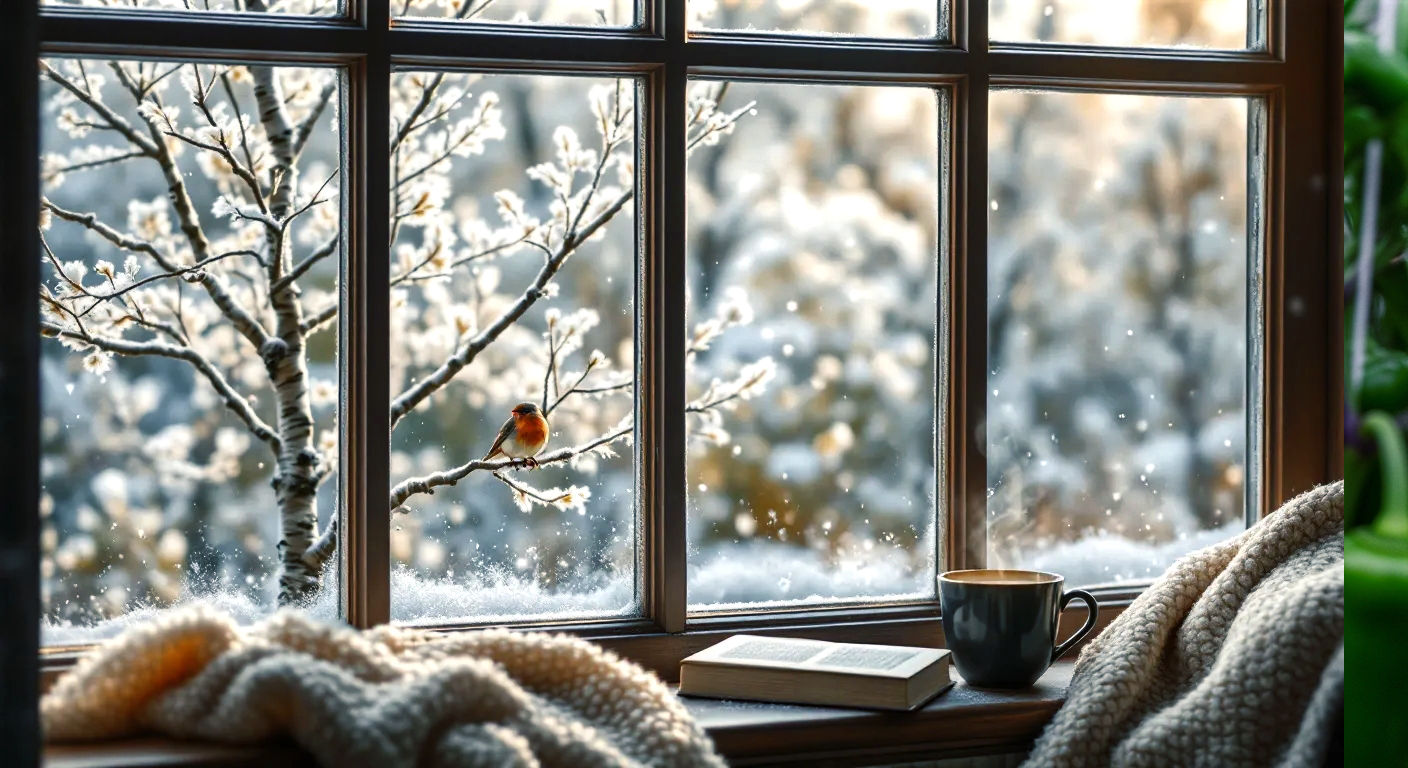Winter Whispers: A Guide to Embracing the Quiet Hush of the British Cold
Discover the magic in the cold months. This guide covers everything from Britain’s winter traditions and wildlife to creating a cosy home and beating the blues.

This post may contain affiliate links. If you make a purchase through these links, we may earn a commission at no additional cost to you.
The world outside the window is painted in shades of grey and silver. The frantic buzz of summer has faded, replaced by something quieter, softer. A thick frost has turned the lawn into a crunchy, sparkling carpet, and your breath hangs in the air like a little ghost. Inside, the kettle is starting to whistle. It’s easy to think of winter as something to be endured, a long, dark tunnel we must trudge through to get to the promise of spring.
But what if we’ve been looking at it all wrong?
What if this quietness isn’t an emptiness, but an invitation? An invitation to slow down, to look closer, and to listen. To listen to the winter whispers—the subtle, magical moments of beauty and peace that only reveal themselves in the cold months. This isn’t about just surviving winter; it’s about truly embracing its deep, restorative hush.
This guide is your map to rediscovering the magic of the British winter. We’ll explore the science behind that peaceful, snowy silence, delve into the cosy traditions that warm our culture, and find the stark beauty waiting in our windswept landscapes. So, grab a cuppa, pull a blanket closer, and let’s learn to love the quiet season.
The Science of the Winter Hush: Why Everything Feels Calmer
Have you ever stepped outside after a fresh snowfall and noticed it? The world seems to have turned its volume down. Car sounds are muffled, distant chatter disappears, and a profound sense of peace hangs in the air. This isn’t just your imagination; it’s physics, and it’s one of winter’s greatest gifts.
The Sound-Proofing Secret of Snow
Think of fresh snow not as a blanket, but as a giant, fluffy sound-absorbing panel covering the whole neighbourhood.
- A Simple Explanation: Snow is full of tiny air pockets between its delicate ice crystals. When a sound wave from a passing car or a barking dog hits the snow, it gets trapped in these little pockets. Instead of bouncing back into the air and reaching your ears, the sound’s energy gets lost, turning into a tiny amount of heat. It’s like the world is suddenly wearing a pair of noise-cancelling headphones.
- A Deeper Look: Acousticians (the scientists who study sound) explain that a thick layer of fresh, powdery snow can absorb over 60% of the sound that hits it. This is because the snow’s structure is porous and complex. The intricate, six-sided flakes create a maze that sound waves can’t easily escape. This is why a winter landscape often feels so wonderfully still and serene—it genuinely is quieter.
The Quiet of the Cold Air
It’s not just the snow. The cold air itself plays a part in this winter hush. On a normal day, the ground is warmer than the air above it. This causes sound waves to bend upwards, away from the ground, allowing them to travel quite far.
In winter, however, we often get something called a temperature inversion, especially at night. This is when the ground gets very cold, making the air just above it colder than the air higher up. This flips the normal rule. Now, sound waves travelling near the ground are bent downwards, back towards the earth. This means they can’t travel as far, effectively shortening the distance that noises can reach you. The world feels smaller, more intimate, and much, much quieter.
The Magic of Winter Light
Winter’s magic isn’t just about sound; it’s also about sight. The sun, bless its heart, hangs low in the sky throughout the day. It never gets directly overhead like it does in July. This low angle has a profound effect on how we see the world.
It creates long, dramatic shadows that stretch across the landscape, revealing textures and contours on the ground that are bleached out by the high sun of summer. It also means the light is softer and more diffused. Think of the difference between a bare lightbulb and a lampshade. The harsh, direct light of summer is the bare bulb; the gentle, golden glow of a winter afternoon is the lampshade. This soft light is less taxing on our eyes and can feel incredibly calming, wrapping the world in a peaceful, ethereal glow. It’s the reason photographers often call the hour after sunrise and before sunset the “golden hour”—and in winter, that beautiful light can last for much of the day.
A Very British Winter: Our Cultural Embrace of the Cold
We Brits have a long and complicated relationship with the cold. We moan about it endlessly, yet our culture is filled with traditions designed not just to cope with winter, but to celebrate it. From ancient rituals to cosy pub fires, we have mastered the art of finding warmth in the dark.
From Pagan Fires to Christmas Markets
Long before Christmas trees and tinsel, our ancestors celebrated the winter solstice around the 21st of December. This was the shortest day of the year, a moment of profound importance. For ancient Celtic and pagan communities, it was a festival of death and rebirth. They lit huge bonfires for Yule to symbolise the returning sun, a beacon of hope to ward off the darkness. They brought evergreens like holly and ivy inside to represent everlasting life.
These ancient traditions never really went away; they just evolved. When Christianity spread across Britain, these pagan symbols were woven into the new festival of Christmas. The holly, the Yule log, the feasting—they are all echoes of a much older way of honouring the winter dark.
Later, it was the Victorians who truly invented the Christmas we know today. Prince Albert, Queen Victoria’s German husband, brought over the tradition of the decorated Christmas tree. Charles Dickens, with A Christmas Carol, cemented the idea of Christmas as a time for family, generosity, and ghost stories told by the fire. Traditions like the Boxing Day walk to blow away the cobwebs, the gloriously silly fun of a Christmas pantomime, and the robin redbreast on a Christmas card—these are all threads in our rich cultural tapestry of winter.
The Winter in Our Stories
British literature is haunted and shaped by winter. It’s a powerful symbol for everything from hardship and despair to quiet reflection and magical transformation.
Think of Shakespeare’s famous line, “Now is the winter of our discontent,” a perfect metaphor for a period of unhappiness. The bleak, windswept moors of the Brontë sisters’ novels are characters in their own right, their harsh winter beauty mirroring the passionate, stormy emotions of the characters.
But winter is also a time of magic. In C.S. Lewis’s The Lion, the Witch and the Wardrobe, the children first enter Narnia to find it trapped in a hundred-year winter, a powerful symbol of a land under a curse. And who can forget the opening of Dickens’ A Christmas Carol? The biting, freezing fog of London is the perfect reflection of Scrooge’s cold heart, which eventually thaws into warmth and joy. These stories teach us that winter is often the setting for the most profound changes.
The Art of Coorie and Hygge (with a British Twist)
In recent years, we’ve heard a lot about hygge, the Danish concept of cosy contentment, and coorie, a wonderful Scottish word that means to snuggle in or nestle. But the truth is, we’ve been doing this for centuries. We just didn’t have a trendy name for it.
The British version of coorie and hygge is found in life’s simple, warming pleasures:
- The Pub Fire: Finding a snug corner in a centuries-old pub, with a roaring fire crackling in the hearth and a pint of good ale in your hand.
- The Sunday Roast: The gathering of family or friends around a table for a proper roast dinner, the ultimate comfort food against the cold.
- A Good Cuppa: The simple, restorative ritual of making and drinking a cup of tea, especially after coming in from a blustery walk.
- The Woolly Jumper: Pulling on a thick, woolly jumper, perhaps one knitted in the Hebrides or the Aran Islands, is like getting a warm hug.
- Listening to the Shipping Forecast: For many, the gentle, rhythmic recitation of the shipping forecast on the radio is the ultimate sound of comfort and safety, a calm voice describing distant storms while you’re tucked up safe and warm.
This is our national talent: finding deep comfort and connection in simple, unpretentious things, especially when the weather is doing its worst.
Rewilding Your Senses: Finding Joy in the Winter Landscape
It’s tempting to hibernate, to stay sealed indoors from November to March. But to do that is to miss one of winter’s most profound secrets: the British countryside is never more beautiful, honest, or revealing than it is in the cold.
The Stark Beauty of a Bare Landscape
Summer is lovely, but its lush greenery can hide the truth of the land. Winter pulls back the curtain. Without the leaves, you see the elegant, skeletal architecture of the trees—the powerful spread of an oak’s branches, the delicate tracery of a silver birch.
You see the bones of the landscape. The ancient stone walls of the Yorkshire Dales and the Cotswolds snake across the hills, their patterns clear for miles. You can trace the gentle contours of the South Downs and see the true, dramatic shapes of the fells in the Lake District without their summer cloak. It’s a quieter, more subtle beauty, one that asks you to look a little closer and appreciate form, structure, and texture.
Don’t be afraid of the mist and the grey skies. They lend a mysterious, atmospheric quality to places like the Scottish Highlands or the Cornish coast, softening the edges of the world and making a familiar walk feel like an adventure into a fairy tale.
Winter Wildlife: The Stars of the Show
Winter can be a fantastic time for wildlife spotting. With the trees bare, it’s much easier to see birds. Look out for the bright flash of a robin, whose song is often louder and clearer in the quiet winter air as it defends its territory.
This is also the time when we get wonderful visitors from the north. Flocks of redwings and fieldfares, thrushes that fly in from Scandinavia, can be seen feasting on berries in the hedgerows. But perhaps the most breathtaking spectacle is a starling murmuration. At dusk, thousands of these birds gather in the sky, swooping and diving in a mesmerising, fluid dance before settling down to roost. It’s one of nature’s greatest free shows.
Look down, too. A layer of frost or a skiff of snow becomes a perfect canvas for tracking. You can see the delicate footprints of birds, the tell-tale tracks of a fox on its nightly patrol, or the path of a deer through the woods.
The Bracing Power of a Winter Walk
There’s a reason we all feel the pull of a Boxing Day walk. Getting out in the cold, even for a short time, is incredibly good for us.
- A Simple Explanation: A brisk walk on a chilly day wakes you up, clears your head, and makes you feel great.
- A Deeper Look: Exposure to bright, natural light—even on a cloudy day—is the most effective way to reset our internal body clocks (circadian rhythms). This helps us sleep better and boosts our mood. In fact, a morning walk is one of the best things you can do to combat the winter blues. The physical effort warms you up and releases endorphins, those feel-good chemicals in your brain. Some scientists also believe that the air in winter, especially near moving water or in forests, is rich in “negative ions,” which can reduce symptoms of depression and increase mental energy.
Organisations like The National Trust and English Heritage keep many of their parks and gardens open all year round, offering stunning, well-maintained paths for a perfect winter wander.
The Indoor Sanctuary: Creating a Haven from the Cold
Embracing winter also means celebrating the joy of coming home. Creating a warm, inviting sanctuary isn’t about extravagance; it’s about consciously crafting a space that feels like a refuge from the wind and the rain.
Mastering the Art of the Cosy Home
Making your home feel cosy is a treat for all your senses.
- Light: Avoid harsh, overhead lights. Instead, use lamps to create warm pools of light. Table lamps, floor lamps, and even fairy lights or candles (used safely, of course!) create a soft, layered glow that is instantly relaxing.
- Texture: This is the secret weapon of cosiness. Think about how things feel. Drape a chunky-knit woollen throw over the sofa. Add a few velvet or flannel cushions. Put a soft sheepskin rug by the bed so it’s the first thing your feet touch in the morning. These textures are comforting and inviting.
- Scent: Our sense of smell is powerfully linked to memory and emotion. Simmer a pot of water on the hob with cinnamon sticks, orange peel, and cloves to fill your home with a festive scent. Light a candle that smells of pine, cedarwood, or gingerbread. The right fragrance can make a space feel instantly warmer.
Winter Feasting: The Taste of Comfort
Winter is the season of comfort food. Our bodies naturally crave heartier, warmer meals when it’s cold outside. This is a time for slow-cooked stews that fill the kitchen with savoury aromas, bubbling fruit crumbles with thick custard, and nourishing soups made from root vegetables.
There’s a science to this. Many classic comfort foods, rich in carbohydrates, can help boost the production of serotonin, a chemical in the brain that contributes to feelings of well-being and happiness. A Sunday roast or a shepherd’s pie isn’t just feeding your body; it’s soothing your mind.
How to Make a Proper Hot Chocolate (The Restorative Kind): Forget the instant powder. For a truly comforting mug, gently heat a cup of whole milk in a small saucepan. Just before it boils, take it off the heat and whisk in 25-30 grams of chopped dark chocolate (at least 70% cocoa) until it’s completely melted and smooth. Add a pinch of sea salt to bring out the flavour. Pour into your favourite mug. This is a hug in a mug.
Finding the Joy of Missing Out (JOMO)
Summer is often filled with social pressure—barbecues, festivals, holidays. The diary is packed. Winter offers a blessed relief. It’s the perfect time to embrace JOMO: the Joy of Missing Out.
This isn’t about becoming a hermit. It’s about swapping frantic activity for mindful, restorative pastimes. It’s permission to say “no” to a night out in favour of a quiet night in with a good book you’ve been meaning to read for ages. It’s a chance to dust off an old hobby, whether it’s painting, knitting, or finally tackling that thousand-piece puzzle of a Cotswold cottage. It’s about rediscovering the pleasure of your own company and the simple, absorbing joy of making or doing something just for yourself.
Beyond the Hush: When Winter Feels Too Quiet
We must be honest. For all its quiet beauty, winter can be tough. The short days and long nights can take a toll on our mental health. Sometimes the hush can feel less like peace and more like loneliness. Acknowledging this is the first step to navigating it with kindness and care.
Understanding the Winter Blues
For some people, the winter blues are more than just a passing mood. Seasonal Affective Disorder (SAD) is a type of depression that comes and goes in a seasonal pattern. Its symptoms can be very debilitating, including a persistent low mood, a lack of energy, and feeling sleepy during the day.
If you feel this way every winter, it’s really important to know that it’s a real and recognised medical condition. Don’t just dismiss it. The most important thing you can do is chat with your GP. They can discuss treatments that really help, such as light therapy, talking therapies, or medication. Organisations like Mind also offer fantastic, practical support and information.
For the milder winter blues, the advice we’ve already discussed can make a huge difference: get as much natural daylight as you can (especially in the morning), stay active with gentle exercise, and eat a balanced diet.
The Importance of Connection
When it’s dark and cold, the effort of seeing people can sometimes feel too much. But this is when connection matters most. Loneliness can be a heavy blanket in winter, so we have to be proactive about lifting it.
It doesn’t have to be a big party. Quality is much more important than quantity.
- Arrange a weekly phone call with a friend or family member.
- Invite a neighbour over for a cup of tea and a biscuit.
- Organise a simple potluck dinner where everyone brings one dish.
- Start a book club or a board game night.
- Join a local walking group to combine exercise, nature, and socialising.
Reaching out not only helps you, but it might just be the lifeline someone else needs, too.
Planting Seeds of Hope for the Spring
Our brains love having something to look forward to. It gives us a sense of hope and purpose. Winter is the perfect time for gentle, forward-looking planning. It’s a reminder that the seasons are a cycle, and the light will always return.
You could spend an afternoon looking through seed catalogues, planning what you’ll grow in the garden or in a window box when spring arrives. You could start researching a summer holiday, giving yourself a little escape to dream about. You could set a small, achievable goal for the new year—not a punishing resolution, but a positive intention, like learning to bake bread or visiting a new part of the country. These small acts of planning are like planting bulbs in the winter dark; you know that, in time, something beautiful will grow.
Conclusion: Learning to Listen to the Whispers
Winter is not the end of the story. It is not an empty pause between the colourful bursts of autumn and spring. It is a vital chapter in its own right—a chapter of rest, reflection, and quiet resilience.
By understanding the science of its stillness, celebrating its cultural warmth, and venturing into its starkly beautiful landscapes, we can change our relationship with the cold. We can learn to see it not as an enemy to be fought, but as a teacher. It teaches us to slow down, to appreciate the small comforts, and to find beauty in simplicity.
So next time the wind howls and the sky is a blanket of grey, don’t just retreat and wait for it to be over. Light a lamp, make a hot drink, and listen. Listen for the gentle tap of rain on the window, the soft crunch of frost underfoot, the cheerful song of a robin in a bare tree.
These are the winter whispers. And they have so much to tell us.
Further Reading & Resources
For those looking to explore winter further, these highly respected British organisations offer a wealth of information and opportunities:
- The National Trust: Discover beautiful winter walks and festive events at historic properties across the UK.
- The Woodland Trust: A fantastic resource for identifying winter trees and learning about the wildlife in our native woods.
- The RSPB (Royal Society for the Protection of Birds): Your go-to guide for spotting winter birds, including information on starling murmurations.
- Mind: Provides essential advice, support, and understanding for anyone struggling with their mental health, including Seasonal Affective Disorder (SAD).
- The Met Office: For a deeper understanding of British winter weather phenomena, from frost to snow.
- English Heritage: Explore historic castles, abbeys, and homes that offer a magical day out, even on the coldest days.






